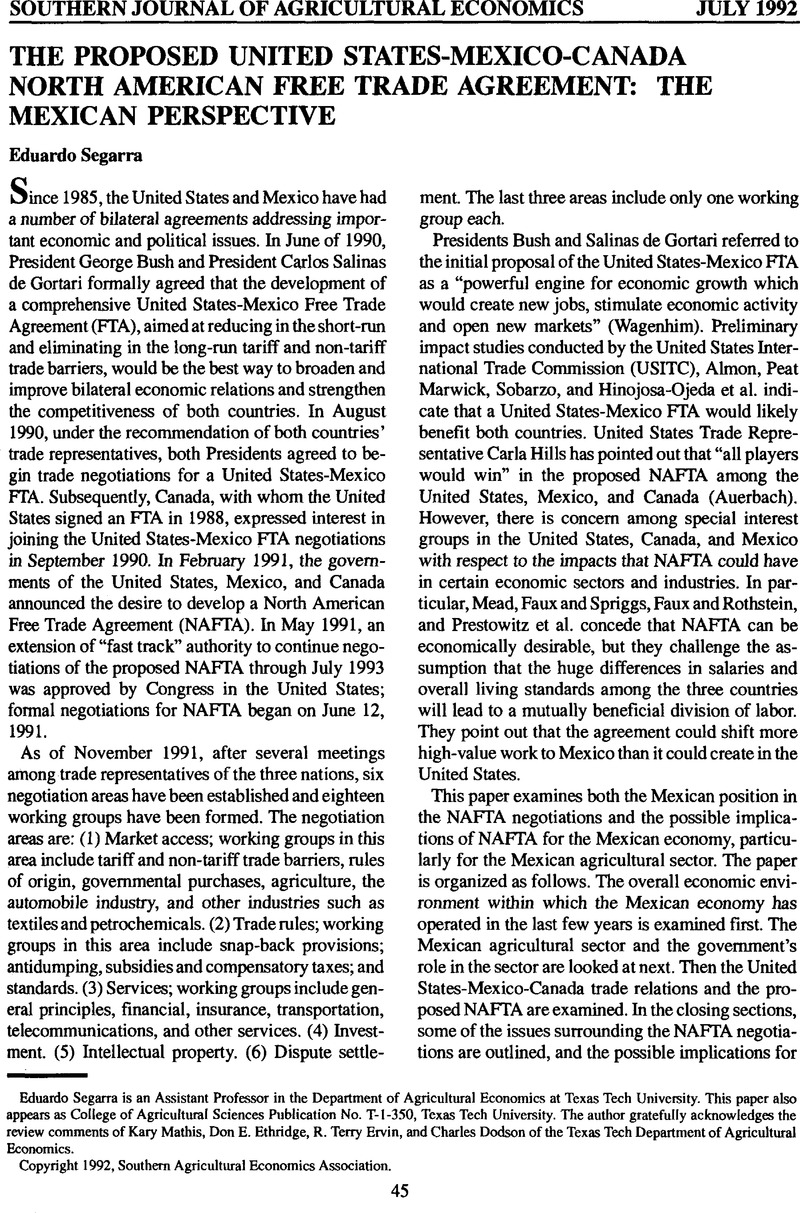No CrossRef data available.
Article contents
The Proposed United States-Mexico-Canada North American Free Trade Agreement: the Mexican Perspective
Published online by Cambridge University Press: 09 September 2016
Abstract
An abstract is not available for this content so a preview has been provided. Please use the Get access link above for information on how to access this content.

- Type
- Invited Papers and Discussions
- Information
- Copyright
- Copyright © Southern Agricultural Economics Association 1992
References
Almon, C. “The U.S.-Mexico Free Trade Agreement: The Impacts to the Industrial Sector.” Preliminary Findings, September 1990.Google Scholar
American Farm Bureau Research Foundation. North American Free Trade Agreement: Effects on Agriculture, Vols. I, II, III, and IV. Chicago, Illinois, January 1992.Google Scholar
Auerbach, S. “U.S., Canada, Mexico Begin Free-Trade Talks.” The Washington Post,
13 June 1991, Section A, p. 6.Google Scholar
Bouis, F. “Free Trade with Mexico: It's Time for Dialogue Among Americans, Commentary.” Choices, Third Quarter, 1991, p. 3.Google Scholar
CIEMEX-WEFA. Maquiladora Industry Analysis, Vol. 3, No. 1, Philadelphia, PA, January 1990.Google Scholar
Cook, R. “North American Free Trade Agreement: Effects on Agriculture.” Video Conference, Chicago, Illinois: American Farm Bureau Research Foundation,
1991.Google Scholar
Dombusch, R. “U.S.-Mexican Trade Relations.” Testimony before the Subcommittee on Trade of the House Committee on Ways and Means. 115th Cong. June 14, 1990.Google Scholar
Environmental Protection Agency and Secretaria de Desarrollo Urbano y Ecologia. Integrated Environmental Plan for the Mexico-U.S Border Area (First Stage 1992-1994), Working Draft, EPA, Washington, D.C., August 1991.Google Scholar
Faux, J. and Rothstein, R.. Fast Track, Fast Shuffle: The Economic Consequences of the Administration's Proposed Free Trade Agreement with Mexico.
Washington, D.C.: Economic Policy Institute,
1991.Google Scholar
Faux, J. and Spriggs, W.. US Jobs and the Mexico Trade Proposal.
Washington, D.C.: Economic Policy Institute,
1991.Google Scholar
Hinojosa-Ojeda, R., Robinson, S., and Moulton, K. S.. “Free Trade Agreement with Mexico: Economic Impacts.” California Agriculture,
45(1991): 5–10.Google Scholar
Kalter, E., and Khor, H. E.. One World, One Economy. A Four-Part Film Series, Instructors Guide. Washington, D.C.: International Monetary Fund,
1990.Google Scholar
Magnusson, P., Symonds, W. C., and Baker, S.. “Suddenly, Free Trade with Mexico is in Trouble.” Business Week, December 16, 1991, p. 54.Google Scholar
Mead, W. R.
The Low-Wage Challenge to Global Growth: The Labor Cost-Productivity Imbalance in Newly Industrialized Countries.
Washington, D.C.: Economic Policy Institute,
1991.Google Scholar
Mexico Business Monthly. Vol. 1, No. 11, December 1991.Google Scholar
Mexico Business Monthly. Vol. 1, No. 12, January 1992.Google Scholar
Montanes Villafana, C. “Los Condicionantes de la Politica Agropecuaria.” Comercio Exterior,
38(1988): 679–685.Google Scholar
Marwick, Peat. “The Impact of a U.S.-Mexico Free Trade Agreement.” Preliminary Results, February 1991.Google Scholar
Perryman, M. Ray, Consultants, Inc. The Economic Impact of Maquiladoras on the McAllen-Hidalgo County Area.
Waco, Texas, March 1989.Google Scholar
Prestowitz, C. V. Jr., Cohen, R. B., Morici, P. A., and Tonelson, A.. The New North American Order: A Win-Win Strategy for US-Mexico Trade.
Washington, D.C.: Economic Strategy Institute,
1991.Google Scholar
Schott, J. J. “More Free Trade Areas?” Free Trade Areas and U.S. Trade Policy,
Schott, J. J., ed. Washington, D.C.: Institute for International Economics,
1989.Google Scholar
Segarra, E.
An Analysis of Mexican Agricultural Price Policies: The Inclusion of Cross-Commodity Effects. Master's thesis, University of Missouri, Columbia, Missouri, August 1982.Google Scholar
Sobarzo, H. “A General Equilibrium Analysis of the Impacts on the Mexican Economy of a North American Free Trade Agreement.” Preliminary results, Unizersivav, Autonoma De Mexico, Mexico City, February 1991.Google Scholar
United States International Trade Commission. The Likely Impact on the United States of a Free Trade Agreement with Mexico.
USITC Publication 2353, Investigation No. 332-297, Washington, D.C., 1991.Google Scholar
“U.S.-Mexico Free Trade Agreement: Expanding Agricultural Trade.” Satellite Conference, Clemson University, Clemson, South Carolina, November 21, 1991.Google Scholar
Viner, J.
The Customs Union Issue.
New York: Carnegie Endowment for International Peace,
1950.Google Scholar
Vollrath, T. L. “A Theoretical Evaluation of Alternative Trade Intensity Measures of Revealed Comparative Advantage.” Review of World Economics, Band 127, Heft 2 (1991,a): 265–280.Google Scholar
Vollrath, T. L., and Scott, L.. “Developing Countries as a Source of U. S. Export Growth.” Developing Economies: Agriculture and Trade Report.
Washington, D.C.: USDA ERS RS-91-5, May 1991.Google Scholar
Wagenhim, K. “Mexico-U.S. Free Trade Agreement is Moving Closer to Reality.” Wall Street Journal, Oct. 1, 1990, Section B, p. 7.Google Scholar


